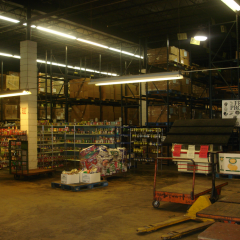
LORTON, Va. (RNS) When Mary Smallenburg, 35, of Fort Belvoir, Va., opened a package from her mother to find cereal and ramen noodles, she burst into tears. Without it, she wouldn’t be able to feed her four children.
“It got to the point where I opened my pantry and there was nothing. Nothing. What was I going to feed my kids?” Smallenburg said, adjusting a bag of fresh groceries on her arm.
Smallenburg’s family is one of 50 military families that regularly visit the Lorton Community Action Center food bank. Volunteers wave a familiar hello as she walks in the door.
“None of what we have been through has been expected,” Smallenburg said. Three of her four children have special needs, and her husband is deployed in Korea. “The last few months, actually, coming here has been a godsend.”
Nationwide, 25 percent of military families — 620,000 households — need help putting food on the table, according to a study by Feeding America, a network of 200 food banks.
“The results are alarming,” said Bob Aiken, chief executive officer of Feeding America. “It means that people in America have to make trade-offs. They have to pick between buying food for their children or paying for utilities, rent and medicine.”
One in seven Americans — 46 million people — rely on food pantries and meal service programs to feed themselves and their families, the study found.
“Hunger exists in literally every county in America,” Aiken said. “It’s an urban problem, it’s a suburban problem, and it’s a rural problem.”
Linda Patterson, executive director of Lorton Community Action Center, said stereotypes of the people who need food assistance are misleading.
“The people who come here are hard workers. They are employed. They are the school bus drivers, the lab techs in doctors offices, receptionists, the janitors who clean the floor of your children’s school,” Patterson said. “They just can’t make ends meet because some kind of crisis has hit them.”
The Hunger in America study found that of people who use food banks:
• 26 percent are black, 20 percent are Hispanic, 43 percent are white and 11 percent are other.
• 33 percent of households have at least one family member with diabetes.
• 65 percent of households have a child under 18 or someone 60 or older.
“Children are going to school, not looking forward to learning but looking forward to eating,” said Shamia Holloway, spokeswoman for the Capital Area Food Bank.
The Lorton Community Action Center has seen an 18 percent increase in people who need food assistance since food stamp benefits were cut in November, Patterson said.
“Many of our families, if they don’t come, will have to choose between paying rent or their kids eating that night,” Patterson said. The median monthly household income of Feeding America network clients is $927.
Sydni Marquesas, 47, of Lorton, works in merchandising. “It doesn’t pay much and they limit your hours,” she said. “Plus, Virginia just made it so hard to apply for SNAP.”
SNAP is the Supplemental Nutrition Assistance Program, what food stamps are called now. Marquesas has used the food bank to get food for herself and her 14-year-old daughter for more than a year and a half.
Recently she started taking nutrition classes through the food bank. “The classes are great,” she said. “I am learning about healthy eating on a budget.”
In the past year, food banks have increased their focus on healthy foods. The study found that 79 percent of people who use food banks report purchasing inexpensive, unhealthy food just to have enough to feed their families.
“We are seeing a change. People are starting to understand the correlation between diet and illness,” said Allison Majewski of the Capital Area Food Bank. “They want healthier food. They are asking for dairy, meats and fresh produce.
“The people who come to us for help are coming more regularly,” Majewski said. “We aren’t a one-time emergency stop anymore. We are a staple for them, so it’s very important that we make these healthy foods available.”
(Natalie DiBlasio writes for USA Today.)






